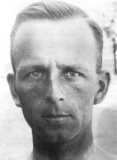Rank SS-Hauptsturmfuhrer Relations 3 children | Name Karl Fritzsch Unit SS-Totenkopfverbande Died May 2, 1945 | |
 | ||
Born 10 July 1903Nassengrub (Mokriny), BohemiaAustria-Hungary ( 1903-07-10 ) Years of service Dachau 1934–1939Auschwitz 1940–1941Flossenburg 1942–1943 Commands held Schutzhaftlagerfuhrer Auschwitz Camp Deputy Spouse(s) Franziska Stich (m. 1928) Similar People Franciszek Gajowniczek, Gerhard Palitzsch, Rudolf Hoss | ||
Karl Fritzsch (10 July 1903 – reported missing 2 May 1945), was a German SS functionary during the Nazi era who served as an Auschwitz concentration camp deputy. According to Rudolf Höss, he first suggested using poisonous gas Zyklon B for the purpose of mass murder and experimented with the first gassings himself.
Contents
Background
Karl Fritzsch was born in Bohemia into the family of a stove builder. His father moved constantly on work assignments, and therefore Fritzsch never received formal education. For some years he worked as a labourer on river ships along the River Danube. His marriage in 1928 to Franziska Stich produced three children, but ended in divorce in 1942. Fritzsch joined the Nazi Party and the SS (NSDAP # 261135 SS # 7287) in 1930 at the age of 27. He became a career SS man. Almost as soon as it opened, he acquired a position at the Dachau concentration camp in 1934.
Due to his camp experience, several months after the German invasion of Poland, in May 1940 he became deputy to Rudolf Höss and the head of the economic operation of Auschwitz (Schutzhaftlagerführer). Fritzsch quickly obtained a reputation as the Auschwitz horror. He used to select prisoners to die of starvation in reprisal for the escape attempts among prisoners. Together with Höss, he was responsible for the torture death of victims locked inside standing cells in the basement of the Bunker, i.e. the Block 11 or 13 prison until they died.
On 29 July 1941, a camp count found that three prisoners were missing and Fritzsch sentenced 10 remaining prisoners to immurement. One of the condemned, Franciszek Gajowniczek, was reprieved when a fellow prisoner, the Franciscan priest Maximilian Kolbe, offered to take his place. After over 2 weeks starvation, only Kolbe remained alive and the priest was killed in the underground bunker by lethal injection. Kolbe was later canonized by Pope John Paul II. Fritzsch was also fond of psychological torture. Former Auschwitz prisoner Karol Świętorzecki recalled the first Christmas Eve behind the camp barbed wire, on 24 December 1940, was also one of the most tragic. "The Nazis set up a Christmas tree, with electric lights, on the roll-call square. Beneath it, they placed the bodies of prisoners who had died while working or frozen to death at roll call. Lagerführer Karl Fritzsch referred to the corpses beneath the tree as “a present” for the living, and forbade the singing of Polish Christmas carols."
According to testimony of his superior Rudolf Höss, it was also Fritzsch who first came up with the idea of using poison gas Zyklon B for the purpose of mass murder. Fritzsch ordered the killing of Soviet POWs locked in cells in the basement of the Bunker while Höss went away on an official trip in late August 1941. Fritzsch tried out the effect of Zyklon B inside cells which were not air-tight, subjecting the victims to even more torturous death. Fritzsch repeated the test-killing of additional victims using Zyklon B soon thereafter in the presence of Höss. According to Höss the preferred method for the mass murders in Auschwitz using Zyklon B was devised on site.
On 15 January 1942, Fritzsch was transferred to KZ Flossenbürg as Schutzhaftlagerführer. From early August until October 1942 he was temporary substitute commander of the camp. In October 1943, he was arrested as a part of an internal SS investigation into corruption. An SS court charged him with murder. As a punishment he was transferred to front line duty (SS-Panzergrenadier-Ersatzbatallion 18). It is assumed that he fell during the battle of Berlin in May 1945.
Disappearance
It is commonly believed that Fritzsch perished in the Battle for Berlin but his final fate remained long unknown. Soviet sources claimed that MI-6 caught him in Norway. In his 2007 memoirs, For He Is an Englishman, Memoirs of a Prussian Nobleman, Captain Charles Arnold-Baker recorded that as an MI6 officer in Oslo he arrested Fritzsch: "We picked up, for example, the deputy commandant of Auschwitz, a little runt of a man called Fritzsch whom we naturally put in the custody of a Jewish guard – with strict instructions not to damage him, of course."
On 4 May 2015 Dutch journalist Wierd Duk published an article on his investigation of Fritzsch's disappearance. In it he cites a report from 1966 by the Central Office of the State Justice Administrations for the Investigation of National Socialist Crimes in which Berlin inhabitant Gertrud Berendes claims that Fritzsch had shot himself on 2 May 1945 in the basement of a house at Sächsische Strasse 42 in Berlin. She mentioned that her father and a neighbour had buried Fritzsch in the Preussenpark and she had sent his personal belongings to his wife. In a separate report from 1966 by the Kriminalpolizei Regensburg, Fritzsch's wife states that she had no reason to doubt her husband's death and that she had received his wedding ring and personal letters. However, Duk's book "De Beul en de Heilige" on Fritzsch that was supposed to be launched first at the end of 2015 and then in 2016 at publisher Prometheus, was postponed indefinitely and has since been removed from the publishers' list of forthcoming books.
